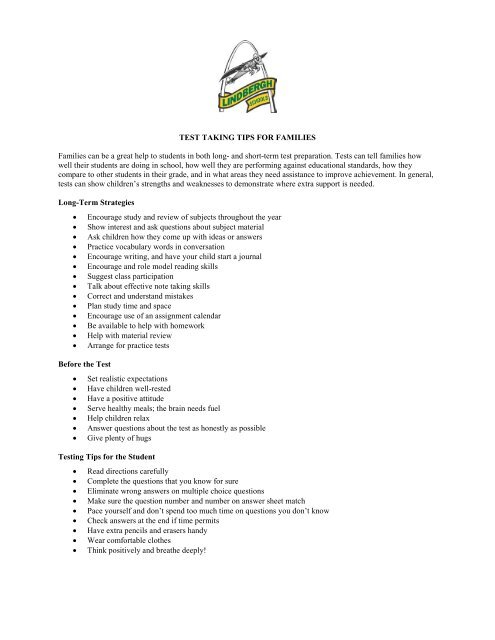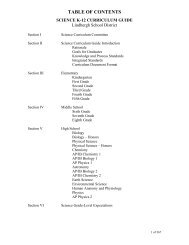test-taking tips you can use with your family. - Lindbergh School ...
test-taking tips you can use with your family. - Lindbergh School ...
test-taking tips you can use with your family. - Lindbergh School ...
You also want an ePaper? Increase the reach of your titles
YUMPU automatically turns print PDFs into web optimized ePapers that Google loves.
TEST TAKING TIPS FOR FAMILIES<br />
Families <strong>can</strong> be a great help to students in both long- and short-term <strong>test</strong> preparation. Tests <strong>can</strong> tell families how<br />
well their students are doing in school, how well they are performing against educational standards, how they<br />
compare to other students in their grade, and in what areas they need assistance to improve achievement. In general,<br />
<strong>test</strong>s <strong>can</strong> show children’s strengths and weaknesses to demonstrate where extra support is needed.<br />
Long-Term Strategies<br />
• Encourage study and review of subjects throughout the year<br />
• Show interest and ask questions about subject material<br />
• Ask children how they come up <strong>with</strong> ideas or answers<br />
• Practice vocabulary words in conversation<br />
• Encourage writing, and have <strong>you</strong>r child start a journal<br />
• Encourage and role model reading skills<br />
• Suggest class participation<br />
• Talk about effective note <strong>taking</strong> skills<br />
• Correct and understand mistakes<br />
• Plan study time and space<br />
• Encourage <strong>use</strong> of an assignment calendar<br />
• Be available to help <strong>with</strong> homework<br />
• Help <strong>with</strong> material review<br />
• Arrange for practice <strong>test</strong>s<br />
Before the Test<br />
• Set realistic expectations<br />
• Have children well-rested<br />
• Have a positive attitude<br />
• Serve healthy meals; the brain needs fuel<br />
• Help children relax<br />
• Answer questions about the <strong>test</strong> as honestly as possible<br />
• Give plenty of hugs<br />
Testing Tips for the Student<br />
• Read directions carefully<br />
• Complete the questions that <strong>you</strong> know for sure<br />
• Eliminate wrong answers on multiple choice questions<br />
• Make sure the question number and number on answer sheet match<br />
• Pace <strong>you</strong>rself and don’t spend too much time on questions <strong>you</strong> don’t know<br />
• Check answers at the end if time permits<br />
• Have extra pencils and erasers handy<br />
• Wear comfortable clothes<br />
• Think positively and breathe deeply!
Ten Tips for Improving Your Child’s Performance on the<br />
MAP Communication Arts Test<br />
The MAP <strong>test</strong> provides data to teachers to help improve instruction and target areas of need for <strong>you</strong>r child(ren). For<br />
that reason, it’s important that <strong>you</strong>r child(ren)’s <strong>test</strong> scores accurately depict their learning. Most of the <strong>tips</strong> found<br />
here are applicable to a variety of grades and may be adjusted to better fit individual situations.<br />
The following is an adaptation from Navigating the MAP: Communication Arts, a publication of the Missouri<br />
Department of Elementary and Secondary Education’s Curriculum Section. The 10 following <strong>tips</strong> were originally<br />
written to aid teachers. We’ve altered the language to accommodate parents. We hope <strong>you</strong> will find the information<br />
and suggestions in these ten <strong>tips</strong> <strong>use</strong>ful as <strong>you</strong> work <strong>with</strong> <strong>you</strong>r children.<br />
Tip #1: Read, read, read!<br />
One of the most surprising findings of research is how little reading students are actually doing. Reading, like any<br />
other skill, takes practice. Students don’t practice reading by doing worksheets; they practice reading by reading.<br />
Therefore, one of the best and simplest steps to improve the reading ability of children is to provide sustained<br />
periods of time for children to read.<br />
Tip #2: Help <strong>you</strong>r child to read like a writer.<br />
One of the best ways to improve reading comprehension is to teach children to read from the point of view of the<br />
writer. Even in the early grades, students <strong>can</strong> begin to “get into the head” of the author. Thinking like a writer<br />
improves both the reading and writing ability of children.<br />
Tip #3: Read a variety of books and magazines.<br />
In the world outside of school, students need to be able to read a wide variety of texts, from road signs to restaurant<br />
menus, from comic books to classics, from tennis shoe ads to computer manuals. The MAP Communication Arts<br />
<strong>test</strong> contains short stories, poems, dialogues, magazines articles, charts and tables. To help <strong>you</strong>r child become savvy<br />
in many reading situations, provide him <strong>with</strong> abundant and diverse reading opportunities.<br />
Tip #4: Build <strong>you</strong>r child’s reading stamina.<br />
One of the main problems children face <strong>with</strong> reading, specifically reading multiple passages on a <strong>test</strong>, is they just<br />
give up. Reading <strong>test</strong>s usually employ a collection of passages of varying difficulty. Some of the passages will be<br />
below grade level; and still others will be above grade level. So the advice to “do the best <strong>you</strong> <strong>can</strong>” is probably<br />
appropriate.<br />
You may also help <strong>you</strong>r child by:<br />
• Creating voices for the characters in books and then re-read the passages using these voices <strong>with</strong><br />
exaggerated expression.<br />
• Re-reading passages aloud.<br />
• Keeping foc<strong>use</strong>d on the text by following along <strong>with</strong> a finger under the words.<br />
To build reading stamina, <strong>you</strong> may want to encourage <strong>you</strong>r child to:<br />
• Gradually increase the amount of time he or she reads at one sitting.<br />
• Set individual reading goals.<br />
• Take short breaks, such as stretching or closing their eyes for a minute.
Tip #5: Teach <strong>you</strong>r child that visuals are part of the text.<br />
Parents may teach children a broader view of the word “text.” On the MAP Communication Arts <strong>test</strong>, items<br />
sometimes require students to do more than just read the words in a passage. Students may need to gather<br />
information from photos, captions, drawings or charts and graphs. You <strong>can</strong> remind <strong>you</strong>r child to look at all of these<br />
materials as part of the total text.<br />
Tip #6: Help <strong>you</strong>r child know how to <strong>use</strong> text-based support in written responses.<br />
Most of the constructed-response items on the MAP Communication Arts <strong>test</strong> contain two parts. First, the student is<br />
asked a content question such as “What is the main idea of this passage?” or “Why is this an appropriate title for the<br />
story?” Second, the student is told to support his or her answers <strong>with</strong> detail and examples from the story. If students<br />
give answers to questions but do not support those answers adequately <strong>with</strong> specific details from the passage, they<br />
will receive only partial credit. This is the most common ca<strong>use</strong> for the loss of points on the <strong>test</strong>. You <strong>can</strong> improve<br />
<strong>you</strong>r child’s score simply by reiterating to <strong>you</strong>r child to <strong>use</strong> specific details from the story.<br />
Tip #7: Teach <strong>you</strong>r child to read the <strong>test</strong> questions first.<br />
While directions on most standardized communication arts <strong>test</strong>s, including the MAP Communication Arts <strong>test</strong>, tell<br />
students to read the passage first and then answer the questions that follow, classroom research has shown that many<br />
students do better if they read the items first, then return to read the passage (Calking 86-87). Reading the questions<br />
first gives students a purpose and direction for their reading. Reading in a <strong>test</strong>ing situation is clearly different than<br />
reading for pleasure. Emphasize to <strong>you</strong>r child that the purpose is to find answers to the specific questions being<br />
asked. Looking at the questions first simply makes more sense in a <strong>test</strong>ing situation.<br />
Tip #8: Help <strong>you</strong>r child find out how many <strong>test</strong> items they <strong>can</strong> hold in memory while reading a passage.<br />
Many elementary students will have trouble remembering more than two questions at a time. Even high school<br />
students probably will run into trouble if they try to remember more than four items at a time. Through practice,<br />
students <strong>can</strong> experiment until they find the best number for each of them individually to try to hold in mind while<br />
reading the <strong>test</strong>. Once students have identified their optimal number of questions to remember, they are ready to<br />
practice using <strong>tips</strong> #7 and #8 together.<br />
Tip #9: Teach <strong>you</strong>r child to identify all parts of a question.<br />
Another <strong>test</strong>-<strong>taking</strong> skill <strong>you</strong> <strong>can</strong> teach <strong>you</strong>r child is how to identify exactly what each question is asking. Some<br />
questions have multiple parts, and these parts are often combined into a single sentence <strong>with</strong> a single question mark<br />
at the end. Students should underline each question word (who, what, when, where, why, how, and any other word<br />
or phrase that indicates a question). By doing so, they <strong>can</strong> see if a question has multiple parts. Not answering all<br />
parts of a multi-part question is a common mistake on the MAP Communication Arts <strong>test</strong>.<br />
Tip #10: Teach <strong>you</strong>r child to paraphrase <strong>test</strong> items, turning questions into statements.<br />
Another strategy that works well in combination <strong>with</strong> the tip above is teaching children to turn questions into<br />
statements. The child may underline the questions words as described above, then turn each part of the item into a<br />
statement. For example, the question “Why did the main character steal the ball?” could be rephrased as “The main<br />
character stole the ball beca<strong>use</strong>…..” This practice allows the child to phrase the question in a way that makes the<br />
most sense to him. He is then ready to read the passage and look for answers.<br />
Most of the above <strong>tips</strong> have been suggested by Missouri teachers, especially those who participated in the state<br />
rescoring of the MAP Communication Arts <strong>test</strong> in the summer of 1998. The other primary source is A Teacher’s<br />
Guide to Standardized Reading Tests, by Lucy Calkins, Kate Montgomery, and Donna Santman (Heinemann 1998).<br />
Both of these sources have been gold mines of practical ideas.








